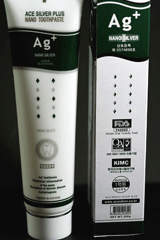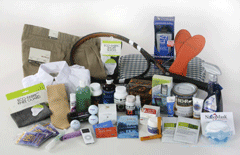Small Technology, Big Questions
Air Date: Week of June 27, 2008

It might give you a gleaming nanosilver smile but what happens once it goes down the drain? (Photo: Alex Parlini, Courtesy of the Project on Emerging Nanotechnologies)
Living on Earth_s new series on nanotechnology explores the big questions about some tiny materials. Manipulating matter at the molecular level opens amazing opportunities for new medicines and materials. But these new materials also create potential risks to health and the environment. Jeff Young looks at nanosilver products already on store shelves.
Transcript
GELLERMAN: It’s Living on Earth, I’m Bruce Gellerman.
The nano technology industry says that very good things will come in very small packages, promising breakthrough medical cures, new materials and revolutionary products. But those tiny packages could also contain some nasty surprises. Nanotechnology deals in the smallest of the small, down at the size of atoms and molecules. But at that scale, things get really strange – carbon nanotubes are stronger than steel and nanogold turns intense red. Living on Earth is thinking big about small things with a new series of stories on nanotechnology we call “Let’s Get Small.”
Today, Living on Earth’s Jeff Young does a little shopping and finds - nanosilver.
[ENTERING GROCERY STORE]
YOUNG: I’m shopping in a Korean grocery store in Germantown, Maryland, with scientist Andrew Maynard. Maynard has just one item on his shopping list.
MAYNARD: This is a toothpaste that is imported from Korea that uses nanosilver particles so we’ll see if we can find it on the shelves here.
[GROCERY STORE NOISES ]
YOUNG: Maynard studies nanotechnology for the Woodrow Wilson International Center for Scholars in Washington. After a little poking around he finds toothpaste that claims that nanosilver will get your teeth cleaner.
MAYNARD: I don’t know about this particular toothpaste but certainly silver as antimicrobial works very well. It’s a very potent antimicrobial agent. Of course the question is if you have something so effective you have to work out how to use it sensibly how to use it wisely and that’s what seems to be lacking at the moment.
YOUNG: Were you surprised to see products like this start to show up?
MAYNARD: Yes I’ve been particularly surprised with products like this where you’re putting nano silver into something where it can definitely get into the body. Either with toothpaste in this form or in kids’ toys, kids pacifiers even. It’s almost as if manufacturers are like kids in a toy store at the moment. They’ve got new technology nanosilver and they’re just putting it everywhere they are so excited about it, but nobody’s really thinking about the long term consequences of that.

Some products made using nanotechnology. (Photo: David Hawxhurst)
MAYNARD: This is perhaps my favorite we have Benny the bear, who is a soft plush toy that has an inside foam impregnated with nanometer size silver particles.
YOUNG: And here’s some socks, same idea?
MAYNARD: Ultra fresh business socks, which contain again silver particles, the idea is that they kill bugs that lead to smelly feet. So you can wear these longer without developing antisocial habits. (Laughs)
YOUNG: Eventually, however, you’re going to want to wash those socks.
[WASHING MACHINE NOISE]
YOUNG: Researchers at Arizona State University found that after about four or five washings most brands start to leak their nanosilver particles, which go out with the water.
[BRUSHING TEETH NOISE]
YOUNG: And of course nanosilver toothpaste is largely going down the drain.
[DRAIN NOISE]
YOUNG: Then what?
ANDERSON: For most communities in the country, the wastewater treatment plant is the first entity to receive these materials.
YOUNG: That’s Cal Baier Anderson a health scientist tracking nanotechnology for the Environmental Defense Fund. She’s been hearing from people who manage sewage plants, who want to know what nanosilver might do to wastewater treatment.
ANDERSON: Bacteria - beneficial bacteria - are very important to this process they degrade or breakdown organic constituents that are present in the wastewater. If you’re introducing something like nano silver which is antibacterial and you wind up killing the good bacteria that will essentially put a halt to the treatment process.
YOUNG: Silver in its regular form can show up in wastewater from photo developing and metal working shops. Federal regulations limit how much can be emitted into rivers, lakes and bays—and for good reason. Silver, while largely benign for humans, is highly toxic to many freshwater fish. George Kimbrel at the non-profit International Center for Technology Assessment filed a petition with the Environmental Protection Agency, asking that nanosilver products be treated as pesticides.
KIMBREL: Nanosilver is quite a bit more toxic, 45 times more, by one study that bulk silver. Almost like a silver on steroids. We don’t know what that will do to the bottom of the food chain, to ecosystems in general.
YOUNG: And there’s another concern that nanosilver in the environment could create a threat to human health. Andrew Maynard of the Woodrow Wilson Center says widespread use could lead to resistant strains of bacteria.
MAYNARD: At the moment silver is one of our last defenses against some of these bugs these microbes that are resistant to many other forms of antimicrobial agents. If we give the secret of our last best defense away, silver, it leaves us with very little else to kill these harmful agents.
YOUNG: It is literally the silver bullet.
MAYNARD: It literally is the silver bullet and I think we have to use it judiciously.
YOUNG: Maynard says all this points to a glaring need for more study into potential environment and health risks. And some on Capitol Hill agree. Congress is working this summer to reauthorize funding for the National Nanotechnology Initiative. The initiative, managed by the White House office of science and technology coordinates about 1.3 billion dollars of nanotech research among a dozen federal agencies. However, only about three percent of that money went to health and environment research. Tennessee Democrat Bart Gordon, who chairs the House science committee, thinks that should be much higher.
GORDON: I don’t think they’ve done enough, although to their credit they have doubled funding in the last couple years, but more needs to be done. We’re gonna hold their feet to the fire.
YOUNG: Gordon says he wants society to realize the benefits of nanotechnology. He’s worried that development of good products could be stifled if the first products to market strike the public as unsafe. He points to the example of genetically modified crops.

It might give you a gleaming nanosilver smile but what happens once it goes down the drain? (Photo: Alex Parlini, Courtesy of the Project on Emerging Nanotechnologies)
YOUNG: There are indications that nanosilver may be starting to lose its shine for some businesses. Consider the case of Benny the bear—you remember the nano-stuffed animal we
met earlier. Benny’s been getting some good publicity lately…
[BENNY BEAR PROMO VIDEO]
TV HOST: This looks like a regular stuffed animal
GUEST: You know it does. But it actually is a very special little guy he’s the first antimicrobial bear so he’s safe for kids with allergies—what that translates to.
HOST: Let’s give one away here we go, Hey!
[CHEERS]
GUEST: Benny the bear!
YOUNG: But Benny’s makers do not like the kind of publicity nanosilver’s been getting. Roy Sharda is a partner in Pure Plushy, the Chicago business that created Benny.
SHARDA: We have used nano silver in the past there’s a lot of speculation as to how much nano silver technology is accepted. Anytime you see controversy you try to sort of avoid it.
YOUNG: Sharda has stopped using nanosilver in Benny the Bear. He says there are just too many questions about the material and how government might regulate it. But Sharda still believes in nanotechnology and thinks that in the long run the nanosilver dispute will be good if it brings more research.
SHARDA: I think it’s better to have this phase of controversy and have the truth come out than the other way around.
YOUNG: Call it the silver lining in the nanosilver products. Yes, commercialization may be getting ahead of needed research. But putting these products in the public’s hands could start an overdue national conversation on nanotechnology, with more people asking the big questions about these tiny materials.
For Living on Earth, I’m Jeff Young in Washington.
GELLERMAN: In the coming weeks, you'll hear more about the small stuff with big potential in our series "Let's Get Small." But If you can’t wait: for more information on nanotechnology, go to our website loe dot org.
Links
Woodrow Wilson Center’s Project on Emerging Nanotechnology
The federal government’s National Nanotechnology Initiative
Nanobusiness Alliance report on industry efforts to address environment and health safety
Environmental Defense Fund’s nanotechnology project
International Center for Technology Assessment’s petition to EPA
Living on Earth wants to hear from you!
Living on Earth
62 Calef Highway, Suite 212
Lee, NH 03861
Telephone: 617-287-4121
E-mail: comments@loe.org
Newsletter [Click here]
Donate to Living on Earth!
Living on Earth is an independent media program and relies entirely on contributions from listeners and institutions supporting public service. Please donate now to preserve an independent environmental voice.
NewsletterLiving on Earth offers a weekly delivery of the show's rundown to your mailbox. Sign up for our newsletter today!
 Sailors For The Sea: Be the change you want to sea.
Sailors For The Sea: Be the change you want to sea.
 The Grantham Foundation for the Protection of the Environment: Committed to protecting and improving the health of the global environment.
The Grantham Foundation for the Protection of the Environment: Committed to protecting and improving the health of the global environment.
 Contribute to Living on Earth and receive, as our gift to you, an archival print of one of Mark Seth Lender's extraordinary wildlife photographs. Follow the link to see Mark's current collection of photographs.
Contribute to Living on Earth and receive, as our gift to you, an archival print of one of Mark Seth Lender's extraordinary wildlife photographs. Follow the link to see Mark's current collection of photographs.
 Buy a signed copy of Mark Seth Lender's book Smeagull the Seagull & support Living on Earth
Buy a signed copy of Mark Seth Lender's book Smeagull the Seagull & support Living on Earth

